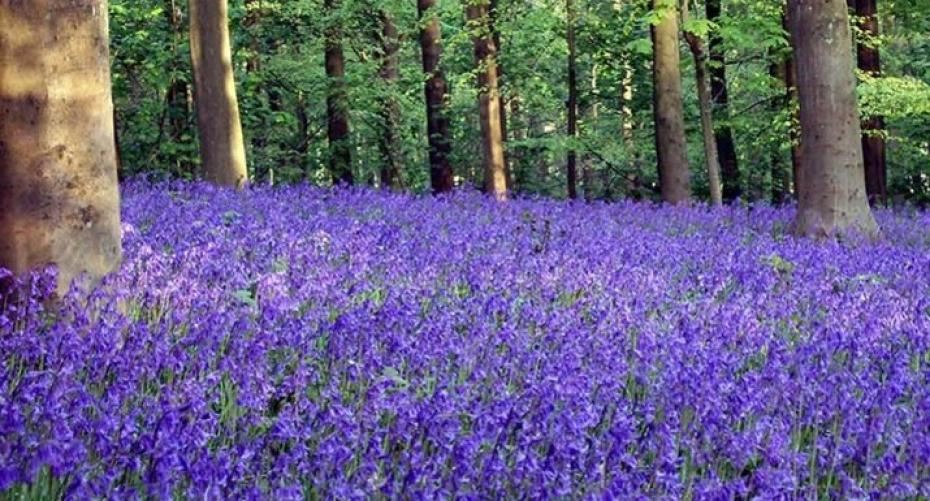Plant snowdrops, English bluebells and aconites just after flowering
Some bulbs, when planted dry, do not have a very good success rate. Planting them just after they have finished flowering, when they still have leaves, ensures an almost 100% success rate. They are usually sold either flowering planted in a pot or as bundles wrapped in paper; if they arrive wrapped in plastic take them out as soon as possible as they can rot. The potted bulbs can be planted at any-time as long as they are still ‘in the green’; the bundles, which won’t be in soil, need to be planted as soon as they have arrived, so make sure you have somewhere planned for them.
When they arrive in a bundle just gently tease them apart taking care not to damage the roots. Plant them to the depth they were originally; you can see where this is from the colour of the stem. The plants will benefit from the addition of compost or leaf mold to the planting hole & soil, if you are concerned about rot, add some coarse sand around the bulb area to improve drainage. If you already have clumps of these bulbs and they are producing fewer and fewer flowers carefully dig up the clump, separate the bulbs and re-plant.
The main bulbs planted ‘in the green’ are Winter Aconites, Snowdrops and English Bluebells.
Eranthis hyemalis (Winter Aconite)
- Bulb, perennial
- Plant: autumn for dry bulbs; in the green in spring
- Flower: February – March
- Flower colour: yellow
- Soil: any, well drained, humus rich
- Where to plant: under deciduous trees or shrubs, front of herbaceous borders
- How to plant: 5cm (2”) deep
- Food and water: keep just damp; feed after flowering with a high potash fertiliser, such as tomato food as this will encourage formation of flowers for next year
- Aspect: sun, partial shade
- Hardiness: hardy
- Height: 8cm (3”)
- Tips: the sap can be an irritant

Galanthus nivalis (Snowdrop)
- Bulb, perennial
- Plant: bulbs in autumn; in the green in spring
- Flower: February – April
- Flower colour: white with green markings
- Soil: any, well drained, moisture retentive
- Where to plant: under deciduous trees and shrubs, front of herbaceous border, containers, rockeries, naturalise in lawns
- How to plant: 4 times own depth
- Food and water: keep just damp; feed after flowering with a high potash fertiliser, such as tomato food as this will encourage formation of flowers for next year
- Aspect: partial shade
- Hardiness: hardy
- Height: 15cm (6”)
- Tips: some are honey scented; lots of varieties, some of them double

Hyacinthoides non-scripta (English Bluebells)
- Bulb, perennial
- Plant: bulbs in autumn; in the green in spring
- Flower: April – May
- Flower colour: blue
- Soil: any, well drained, moisture retentive, humus rich
- Where to plant: naturalised under deciduous trees
- How to plant: 3- 4 times own depth
- Food and water: keep just damp; feed after flowering with a high potash fertiliser, such as tomato food as this will encourage formation of flowers for next year
- Aspect: partial shade
- Hardiness: hardy
- Height: 40cm (16”)
- Tips: don’t plant Spanish bluebells as they are stronger than the English and hybridise with them so putting the English bluebell under threat
For more information and inspiration on what you can plant in spring just get in touch with the Outdoor Plant team here in store.




![Kingsbury-bench-05[1].jpg](http://www.hayesgardenworld.co.uk/cdn/shop/files/Kingsbury-bench-05_5B1_5D.jpg?v=1712162737&width=1500)
![Kingsbury-bench-01[1].jpg](http://www.hayesgardenworld.co.uk/cdn/shop/files/Kingsbury-bench-01_5B1_5D.jpg?v=1712161065&width=1500)
![tw17a-4947_0[1].jpg](http://www.hayesgardenworld.co.uk/cdn/shop/files/tw17a-4947_0_5B1_5D.jpg?v=1712161495&width=1500)
![tw17a-4947_tenbury_5ft[1].jpg](http://www.hayesgardenworld.co.uk/cdn/shop/files/tw17a-4947_tenbury_5ft_5B1_5D.jpg?v=1712161172&width=1500)
![tw17a-4952_tenbury_4ft[1].jpg](http://www.hayesgardenworld.co.uk/cdn/shop/files/tw17a-4952_tenbury_4ft_5B1_5D.jpg?v=1712161034&width=1500)
![thumbnail_IMG_1565-kik_2[1].jpg](http://www.hayesgardenworld.co.uk/cdn/shop/files/thumbnail_IMG_1565-kik_2_5B1_5D.jpg?v=1712226536&width=1500)
![thumbnail_IMG_1565-kik_1[3].jpg](http://www.hayesgardenworld.co.uk/cdn/shop/files/thumbnail_IMG_1565-kik_1_5B3_5D.jpg?v=1712159637&width=1500)



![WD-XgESA[1].jpeg](http://www.hayesgardenworld.co.uk/cdn/shop/files/WD-XgESA_5B1_5D.jpg?v=1712159609&width=1500)